1GB, 2GB, 4GB (x64, SR) 204-Pin DDR3 SODIMM
Features
DDR3 SDRAM SODIMM
MT8JTF12864HZ – 1GB
MT8JTF25664HZ – 2GB
MT8JTF51264HZ – 4GB
Features
• DDR3 functionality and operations supported as
defined in the component data sheet
• 204-pin, small-outline dual in-line memory module
(SODIMM)
• Fast data transfer rates: PC3-12800, PC3-10600,
PC3-8500, or PC3-6400
• 1GB (128 Meg x 64), 2GB (256 Meg x 64),
4GB (512 Meg x 64)
• VDD = 1.5V ±0.075V
• VDDSPD = 3.0–3.6V
• Nominal and dynamic on-die termination (ODT) for
data, strobe, and mask signals
• Single-rank
• Serial presence-detect (SPD) EEPROM
• 8 internal device banks
• Fixed burst chop (BC) of 4 and burst length (BL) of 8
via the mode register set (MRS)
• Selectable BC4 or BL8 on-the-fly (OTF)
• Gold edge contacts
• Halogen-free
• Fly-by topology
• Terminated control, command, and address bus
Table 1: Key Timing Parameters
Figure 1: 204-Pin SODIMM (MO-268 R/C B)
Module height: 30mm (1.181in)
Options
• Operating temperature
– Commercial (0°C ≤ TA ≤ +70°C)
• Package
– 204-pin DIMM (halogen-free)
• Frequency/CAS latency
– 1.25ns @ CL = 11 (DDR3-1600)
– 1.5ns @ CL = 9 (DDR3-1333)
– 1.87ns @ CL = 7 (DDR3-1066)
Marking
None
Z
-1G6
-1G4
-1G1
Speed
Grade
-1G6
-1G4
-1G1
-1G0
-80B
Industry
Nomenclature
PC3-12800
PC3-10600
PC3-8500
PC3-8500
PC3-6400
–
–
–
–
CL = 11 CL = 10 CL = 9
1333
1333
1333
1333
1600
–
–
–
–
–
–
Data Rate (MT/s)
CL = 8
1066
1066
1066
1066
–
CL = 7
1066
1066
1066
–
–
CL = 6
CL = 5
800
800
800
800
800
667
667
667
667
667
tRCD
(ns)
13.125
13.125
13.125
15
15
tRP
(ns)
13.125
13.125
13.125
15
15
tRC
(ns)
48.125
49.125
50.625
52.5
52.5
PDF: 09005aef8441a29e
jtf8c128_256_512x64hz.pdf - Rev. G 5/13 EN
1
Micron Technology, Inc. reserves the right to change products or specifications without notice.
© 2010 Micron Technology, Inc. All rights reserved.
Products and specifications discussed herein are subject to change by Micron without notice.
�
1GB, 2GB, 4GB (x64, SR) 204-Pin DDR3 SODIMM
Features
Table 2: Addressing
Parameter
Refresh count
Row address
Device bank address
Device configuration
Column address
Module rank address
1GB
8K
16K A[13:0]
8 BA[2:0]
2GB
8K
32K A[14:0]
8 BA[2:0]
4GB
8K
64K A[15:0]
8 BA[2:0]
1Gb (128 Meg x 8)
2Gb (256 Meg x 8)
4Gb (512 Meg x 8)
1K A[9:0]
1 S0#
1K A[9:0]
1 S0#
1K A[9:0]
1 S0#
Table 3: Part Numbers and Timing Parameters – 1GB Modules
Base device: MT41J128M8,1 1Gb DDR3 SDRAM
Part Number2
MT8JTF12864HZ-1G6__
MT8JTF12864HZ-1G4__
MT8JTF12864HZ-1G1__
Module
Density
1GB
1GB
1GB
Configuration
128 Meg x 64
128 Meg x 64
128 Meg x 64
Module
Bandwidth
12.8 GB/s
10.6 GB/s
8.5 GB/s
Memory Clock/
Data Rate
1.25ns/1600 MT/s
1.5ns/1333 MT/s
1.87ns/1066 MT/s
Clock Cycles
(CL-tRCD-tRP)
11-11-11
9-9-9
7-7-7
Table 4: Part Numbers and Timing Parameters – 2GB Modules
Base device: MT41J256M8,1 2Gb DDR3 SDRAM
Part Number2
MT8JTF25664HZ-1G6__
MT8JTF25664HZ-1G4__
MT8JTF25664HZ-1G1__
Module
Density
2GB
2GB
2GB
Configuration
256 Meg x 64
256 Meg x 64
256 Meg x 64
Module
Bandwidth
12.8 GB/s
10.6 GB/s
8.5 GB/s
Memory Clock/
Data Rate
1.25ns/1600 MT/s
1.5ns/1333 MT/s
1.87ns/1066 MT/s
Clock Cycles
(CL-tRCD-tRP)
11-11-11
9-9-9
7-7-7
Table 5: Part Numbers and Timing Parameters – 4GB Modules
Base device: MT41J512M8,1 4Gb DDR3 SDRAM
Part Number2
MT8JTF51264HZ-1G6__
MT8JTF51264HZ-1G4__
MT8JTF51264HZ-1G1__
Module
Density
4GB
4GB
4GB
Configuration
512 Meg x 64
512 Meg x 64
512 Meg x 64
Module
Bandwidth
12.8 GB/s
10.6 GB/s
8.5 GB/s
Memory Clock/
Data Rate
1.25ns/1600 MT/s
1.5ns/1333 MT/s
1.87ns/1066 MT/s
Clock Cycles
(CL-tRCD-tRP)
11-11-11
9-9-9
7-7-7
Notes:
1. The data sheet for the base device can be found on Micron’s Web site.
2. All part numbers end with a two-place code (not shown) that designates component and PCB revisions.
Consult factory for current revision codes. Example: MT8JTF51264HZ-1G6E1.
PDF: 09005aef8441a29e
jtf8c128_256_512x64hz.pdf - Rev. G 5/13 EN
2
Micron Technology, Inc. reserves the right to change products or specifications without notice.
© 2010 Micron Technology, Inc. All rights reserved.
�
1GB, 2GB, 4GB (x64, SR) 204-Pin DDR3 SODIMM
Pin Assignments
Pin Assignments
Table 6: Pin Assignments
204-Pin DDR3 SODIMM Front
204-Pin DDR3 SODIMM Back
VREFDQ
DQ42
DQ43
VSS
DQ48
DQ49
VSS
VSS
DQ0
DQ1
VSS
DM0
VSS
DQ2
DQ3
VSS
DQ8
DQ9
VSS
VDD
A10
BA0
VDD
WE#
CAS#
VDD
A13
NC
VDD
NC
VSS
DQ32
DQ33
VSS
Pin Symbol Pin Symbol Pin Symbol Pin Symbol
1
3
5
7
9
11
13
15
17
19
21
23
25
27
29
31
33
35
37
39
41
43
45
47
49
51
DQ19
VSS
DQ24
DQ25
VSS
DM3
VSS
DQ26
DQ27
VSS
CKE0
VDD
NC
BA2
VDD
A12
A9
VDD
A8
A5
VDD
A3
A1
VDD
CK0
CK0#
DQS6#
DQS6
VSS
DQ50
DQ51
VSS
DQ56
DQ57
VSS
DM7
VSS
DQ58
DQ59
VSS
SA0
VDDSPD
SA1
VTT
–
–
105
107
109
111
113
115
117
119
121
123
125
127
129
131
133
135
137
139
141
143
145
147
149
151
153
155
157
159
161
163
165
167
169
171
173
175
177
179
181
183
185
187
189
191
193
195
197
199
201
203
–
–
53
55
57
59
61
63
65
67
69
71
73
75
77
79
81
83
85
87
89
91
93
95
97
99
101
103
DQS4#
DQS4
VSS
DQ34
DQ35
VSS
DQ40
DQ41
VSS
DM5
VSS
DQS1#
DQS1
VSS
DQ10
DQ11
VSS
DQ16
DQ17
VSS
DQS2#
DQS2
VSS
DQ18
VSS
DQ4
DQ5
VSS
VDD
BA1
RAS#
VDD
S0#
ODT0
VDD
NC
NC
VDD
VREFCA
DQS0#
DQS0
VSS
DQ6
DQ7
VSS
DQ12
DQ13
VSS
DM1
RESET#
DQ46
DQ47
VSS
DQ52
DQ53
VSS
DM6
VSS
DQ54
DQ55
VSS
DQ60
DQ61
VSS
Pin Symbol Pin Symbol Pin Symbol Pin Symbol
2
4
6
8
10
12
14
16
18
20
22
24
26
28
30
32
34
36
38
40
42
44
46
48
50
52
VSS
DQ28
DQ29
VSS
DQ3#
DQ3
VSS
DQ30
DQ31
VSS
NC
VDD
A15
A14
VDD
A11
A7
VDD
A6
A4
VDD
A2
A0
VDD
CK1
CK1#
106
108
110
112
114
116
118
120
122
124
126
128
130
132
134
136
138
140
142
144
146
148
150
152
154
156
158
160
162
164
166
168
170
172
174
176
178
180
182
184
186
188
190
192
194
196
198
200
202
204
–
–
54
56
58
60
62
64
66
68
70
72
74
76
78
80
82
84
86
88
90
92
94
96
98
100
102
104
DQS7#
DQS7
VSS
DQ62
DQ63
VSS
NF
SDA
SCL
VTT
–
–
VSS
DQ36
DQ37
VSS
DM4
VSS
DQ38
DQ39
VSS
DQ44
DQ45
VSS
VSS
DQ14
DQ15
VSS
DQ20
DQ21
VSS
DM2
VSS
DQ22
DQ23
DQS5#
DQS5
VSS
PDF: 09005aef8441a29e
jtf8c128_256_512x64hz.pdf - Rev. G 5/13 EN
3
Micron Technology, Inc. reserves the right to change products or specifications without notice.
© 2010 Micron Technology, Inc. All rights reserved.
�
1GB, 2GB, 4GB (x64, SR) 204-Pin DDR3 SODIMM
Pin Descriptions
Pin Descriptions
The pin description table below is a comprehensive list of all possible pins for all DDR3
modules. All pins listed may not be supported on this module. See Pin Assignments for
information specific to this module.
Table 7: Pin Descriptions
Symbol
Ax
Type
Input
BAx
Input
CKx,
CKx#
CKEx
DMx
Input
Input
Input
ODTx
Input
Par_In
RAS#, CAS#, WE#
Input
Input
RESET#
Input
(LVCMOS)
Sx#
SAx
SCL
CBx
DQx
DQSx,
DQSx#
Input
Input
Input
I/O
I/O
I/O
Description
Address inputs: Provide the row address for ACTIVE commands, and the column ad-
dress and auto precharge bit (A10) for READ/WRITE commands, to select one location
out of the memory array in the respective bank. A10 sampled during a PRECHARGE
command determines whether the PRECHARGE applies to one bank (A10 LOW, bank
selected by BAx) or all banks (A10 HIGH). The address inputs also provide the op-code
during a LOAD MODE command. See the Pin Assignments Table for density-specific
addressing information.
Bank address inputs: Define the device bank to which an ACTIVE, READ, WRITE, or
PRECHARGE command is being applied. BA define which mode register (MR0, MR1,
MR2, or MR3) is loaded during the LOAD MODE command.
Clock: Differential clock inputs. All control, command, and address input signals are
sampled on the crossing of the positive edge of CK and the negative edge of CK#.
Clock enable: Enables (registered HIGH) and disables (registered LOW) internal circui-
try and clocks on the DRAM.
Data mask (x8 devices only): DM is an input mask signal for write data. Input data
is masked when DM is sampled HIGH, along with that input data, during a write ac-
cess. Although DM pins are input-only, DM loading is designed to match that of the
DQ and DQS pins.
On-die termination: Enables (registered HIGH) and disables (registered LOW) termi-
nation resistance internal to the DDR3 SDRAM. When enabled in normal operation,
ODT is only applied to the following pins: DQ, DQS, DQS#, DM, and CB. The ODT input
will be ignored if disabled via the LOAD MODE command.
Parity input: Parity bit for Ax, RAS#, CAS#, and WE#.
Command inputs: RAS#, CAS#, and WE# (along with S#) define the command being
entered.
Reset: RESET# is an active LOW asychronous input that is connected to each DRAM
and the registering clock driver. After RESET# goes HIGH, the DRAM must be reinitial-
ized as though a normal power-up was executed.
Chip select: Enables (registered LOW) and disables (registered HIGH) the command
decoder.
Serial address inputs: Used to configure the temperature sensor/SPD EEPROM ad-
dress range on the I2C bus.
Serial clock for temperature sensor/SPD EEPROM: Used to synchronize communi-
cation to and from the temperature sensor/SPD EEPROM on the I2C bus.
Check bits: Used for system error detection and correction.
Data input/output: Bidirectional data bus.
Data strobe: Differential data strobes. Output with read data; edge-aligned with
read data; input with write data; center-aligned with write data.
PDF: 09005aef8441a29e
jtf8c128_256_512x64hz.pdf - Rev. G 5/13 EN
4
Micron Technology, Inc. reserves the right to change products or specifications without notice.
© 2010 Micron Technology, Inc. All rights reserved.
�
1GB, 2GB, 4GB (x64, SR) 204-Pin DDR3 SODIMM
Pin Descriptions
Table 7: Pin Descriptions (Continued)
Symbol
SDA
TDQSx,
TDQSx#
Err_Out#
EVENT#
VDD
VDDSPD
VREFCA
VREFDQ
VSS
VTT
NC
NF
Type
I/O
Output
Output
(open drain)
Output
(open drain)
Supply
Supply
Supply
Supply
Supply
Supply
–
–
Description
Serial data: Used to transfer addresses and data into and out of the temperature sen-
sor/SPD EEPROM on the I2C bus.
Redundant data strobe (x8 devices only): TDQS is enabled/disabled via the LOAD
MODE command to the extended mode register (EMR). When TDQS is enabled, DM is
disabled and TDQS and TDQS# provide termination resistance; otherwise, TDQS# are
no function.
Parity error output: Parity error found on the command and address bus.
Temperature event:The EVENT# pin is asserted by the temperature sensor when criti-
cal temperature thresholds have been exceeded.
Power supply: 1.5V ±0.075V. The component VDD and VDDQ are connected to the
module VDD.
Temperature sensor/SPD EEPROM power supply: 3.0–3.6V.
Reference voltage: Control, command, and address VDD/2.
Reference voltage: DQ, DM VDD/2.
Ground.
Termination voltage: Used for control, command, and address VDD/2.
No connect: These pins are not connected on the module.
No function: These pins are connected within the module, but provide no functional-
ity.
PDF: 09005aef8441a29e
jtf8c128_256_512x64hz.pdf - Rev. G 5/13 EN
5
Micron Technology, Inc. reserves the right to change products or specifications without notice.
© 2010 Micron Technology, Inc. All rights reserved.
�
1GB, 2GB, 4GB (x64, SR) 204-Pin DDR3 SODIMM
DQ Map
DQ Map
Table 8: Component-to-Module DQ Map
Component
Reference
Number
U1
U3
U6
U8
Component
Module Pin
DQ
0
1
2
3
4
5
6
7
0
1
2
3
4
5
6
7
0
1
2
3
4
5
6
7
0
1
2
3
4
5
6
7
Module DQ
Number
2
1
6
5
7
0
3
4
34
36
38
33
35
32
39
37
61
62
57
58
60
59
56
63
29
26
25
31
24
30
28
27
15
7
16
6
18
5
17
4
141
130
140
131
143
129
142
132
182
192
183
191
180
193
181
194
58
67
59
70
57
68
56
69
Component
Reference
Number
U2
U4
U7
U9
Component
Module Pin
DQ
0
1
2
3
4
5
6
7
0
1
2
3
4
5
6
7
0
1
2
3
4
5
6
7
0
1
2
3
4
5
6
7
Module DQ
Number
22
17
18
21
23
16
19
20
50
53
54
49
55
48
51
52
45
42
44
46
40
47
41
43
9
10
13
11
12
15
8
14
50
41
51
42
52
39
53
40
175
166
174
165
176
163
177
164
148
157
146
158
147
160
149
159
23
33
24
35
22
36
21
34
PDF: 09005aef8441a29e
jtf8c128_256_512x64hz.pdf - Rev. G 5/13 EN
6
Micron Technology, Inc. reserves the right to change products or specifications without notice.
© 2010 Micron Technology, Inc. All rights reserved.
�
1GB, 2GB, 4GB (x64, SR) 204-Pin DDR3 SODIMM
Functional Block Diagram
Functional Block Diagram
Figure 2: Functional Block Diagram
S0#
DQS0#
DQS0
DM0
DQS1#
DQS1
DM1
DQS2#
DQS2
DM2
DQS3#
DQS3
DM3
DQ0
DQ1
DQ2
DQ3
DQ4
DQ5
DQ6
DQ7
VSS
DQ8
DQ9
DQ10
DQ11
DQ12
DQ13
DQ14
DQ15
VSS
DQ16
DQ17
DQ18
DQ19
DQ20
DQ21
DQ22
DQ23
VSS
DQ24
DQ25
DQ26
DQ27
DQ28
DQ29
DQ30
DQ31
VSS
DM CS# DQS DQS#
U1
DM CS# DQS DQS#
U9
DM CS# DQS DQS#
U2
DM CS# DQS DQS#
U8
DQ
DQ
DQ
DQ
DQ
DQ
DQ
DQ
ZQ
DQ
DQ
DQ
DQ
DQ
DQ
DQ
DQ
ZQ
DQ
DQ
DQ
DQ
DQ
DQ
DQ
DQ
ZQ
DQ
DQ
DQ
DQ
DQ
DQ
DQ
DQ
ZQ
DQS4#
DQS4
DM4
DQS5#
DQS5
DM5
DQS6#
DQS6
DM6
DQS7#
DQS7
DM7
DQ32
DQ33
DQ34
DQ35
DQ36
DQ37
DQ38
DQ39
VSS
DQ40
DQ41
DQ42
DQ43
DQ44
DQ45
DQ46
DQ47
VSS
DQ48
DQ49
DQ50
DQ51
DQ52
DQ53
DQ54
DQ55
VSS
DQ56
DQ57
DQ58
DQ59
DQ60
DQ61
DQ62
DQ63
VSS
DQ
DQ
DQ
DQ
DQ
DQ
DQ
DQ
ZQ
DQ
DQ
DQ
DQ
DQ
DQ
DQ
DQ
ZQ
DQ
DQ
DQ
DQ
DQ
DQ
DQ
DQ
ZQ
DQ
DQ
DQ
DQ
DQ
DQ
DQ
DQ
ZQ
DM CS# DQS DQS#
U3
U7
DM CS# DQS DQS#
U5
SCL
SPD EEPROM
A1 A2
WP
A0
SDA
VSS
SA0
SA1
VSS
BA[2:0]: DDR3 SDRAM
A[15/14/13:0]: DDR3 SDRAM
RAS#: DDR3 SDRAM
CAS#: DDR3 SDRAM
WE#: DDR3 SDRAM
CKE0: DDR3 SDRAM
ODT0: DDR3 SDRAM
RESET#: DDR3 SDRAM
DDR3 SDRAM x 8
BA[2:0]
A[15/14/13:0]
RAS#
CAS#
WE#
CKE0
ODT0
RESET#
CK0
CK0#
CK1
CK1#
Clock, control, command, and address line terminations:
DM CS# DQS DQS#
CKE0, A[15/14/13:0],
RAS#, CAS#, WE#,
S0#, ODT0, BA[2:0]
U4
DM CS# DQS DQS#
U6
CK
CK#
VDDSPD
V DD
VTT
VREFCA
VREFDQ
VSS
DDR3
SDRAM
DDR3
SDRAM
VTT
VDD
SPD EEPROM
DDR3 SDRAM
Control, command,
and address termination
DDR3 SDRAM
DDR3 SDRAM
DDR3 SDRAM
Note:
1. The ZQ ball on each DDR3 component is connected to an external 240Ω ±1% resistor
that is tied to ground. It is used for the calibration of the component’s ODT and output
driver.
PDF: 09005aef8441a29e
jtf8c128_256_512x64hz.pdf - Rev. G 5/13 EN
7
Micron Technology, Inc. reserves the right to change products or specifications without notice.
© 2010 Micron Technology, Inc. All rights reserved.
�
General Description
1GB, 2GB, 4GB (x64, SR) 204-Pin DDR3 SODIMM
General Description
DDR3 SDRAM modules are high-speed, CMOS dynamic random access memory mod-
ules that use internally configured 8-bank DDR3 SDRAM devices. DDR3 SDRAM mod-
ules use DDR architecture to achieve high-speed operation. DDR3 architecture is essen-
tially an 8n-prefetch architecture with an interface designed to transfer two data words
per clock cycle at the I/O pins. A single read or write access for the DDR3 SDRAM mod-
ule effectively consists of a single 8n-bit-wide, one-clock-cycle data transfer at the inter-
nal DRAM core and eight corresponding n-bit-wide, one-half-clock-cycle data transfers
at the I/O pins.
DDR3 modules use two sets of differential signals: DQS, DQS# to capture data and CK
and CK# to capture commands, addresses, and control signals. Differential clocks and
data strobes ensure exceptional noise immunity for these signals and provide precise
crossing points to capture input signals.
DDR3 modules use faster clock speeds than earlier DDR technologies, making signal
quality more important than ever. For improved signal quality, the clock, control, com-
mand, and address buses have been routed in a fly-by topology, where each clock, con-
trol, command, and address pin on each DRAM is connected to a single trace and ter-
minated (rather than a tree structure, where the termination is off the module near the
connector). Inherent to fly-by topology, the timing skew between the clock and DQS sig-
nals can be easily accounted for by using the write-leveling feature of DDR3.
Fly-By Topology
Serial Presence-Detect EEPROM Operation
DDR3 SDRAM modules incorporate serial presence-detect. The SPD data is stored in a
256-byte EEPROM. The first 128 bytes are programmed by Micron to comply with
JEDEC standard JC-45, "Appendix X: Serial Presence Detect (SPD) for DDR3 SDRAM
Modules." These bytes identify module-specific timing parameters, configuration infor-
mation, and physical attributes. The remaining 128 bytes of storage are available for use
by the customer. System READ/WRITE operations between the master (system logic)
and the slave EEPROM device occur via a standard I2C bus using the DIMM’s SCL
(clock) SDA (data), and SA (address) pins. Write protect (WP) is connected to V SS, per-
manently disabling hardware write protection. For further information refer to Micron
technical note TN-04-42, "Memory Module Serial Presence-Detect."
PDF: 09005aef8441a29e
jtf8c128_256_512x64hz.pdf - Rev. G 5/13 EN
8
Micron Technology, Inc. reserves the right to change products or specifications without notice.
© 2010 Micron Technology, Inc. All rights reserved.
�
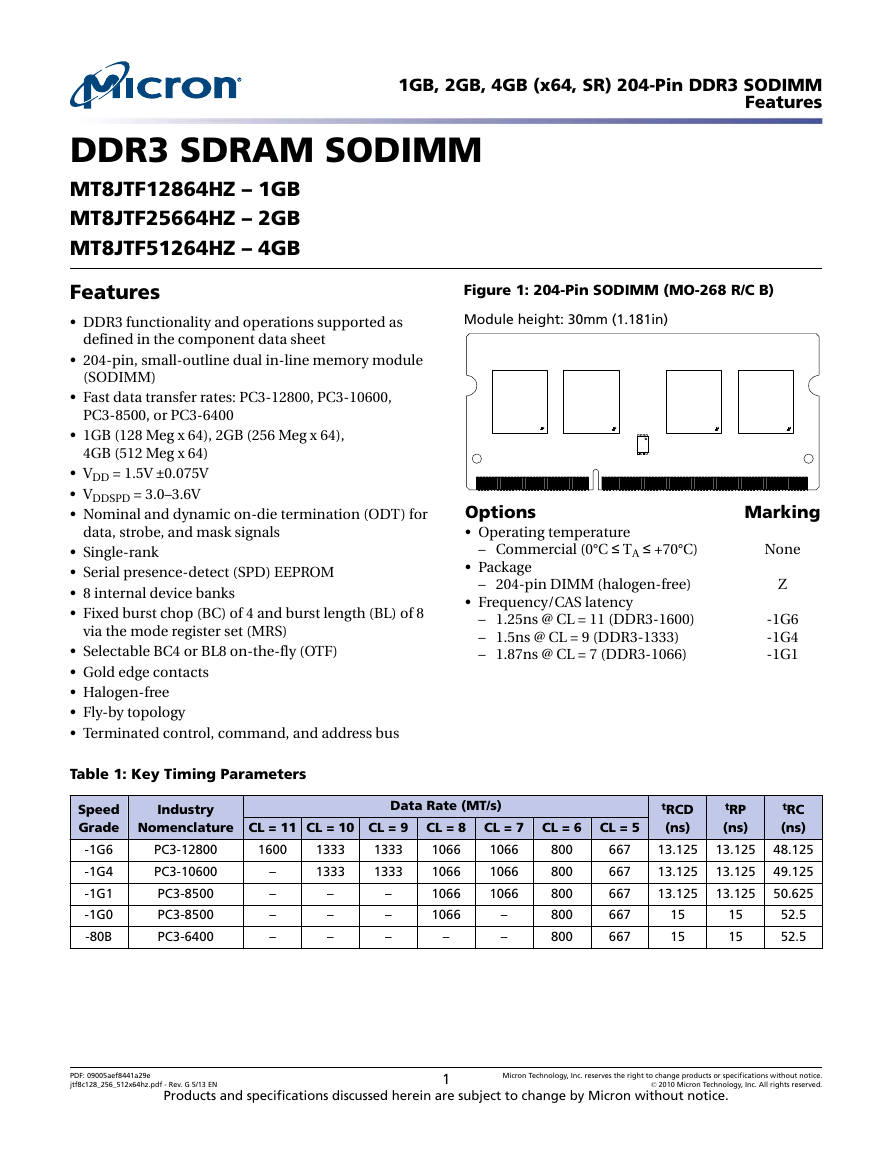

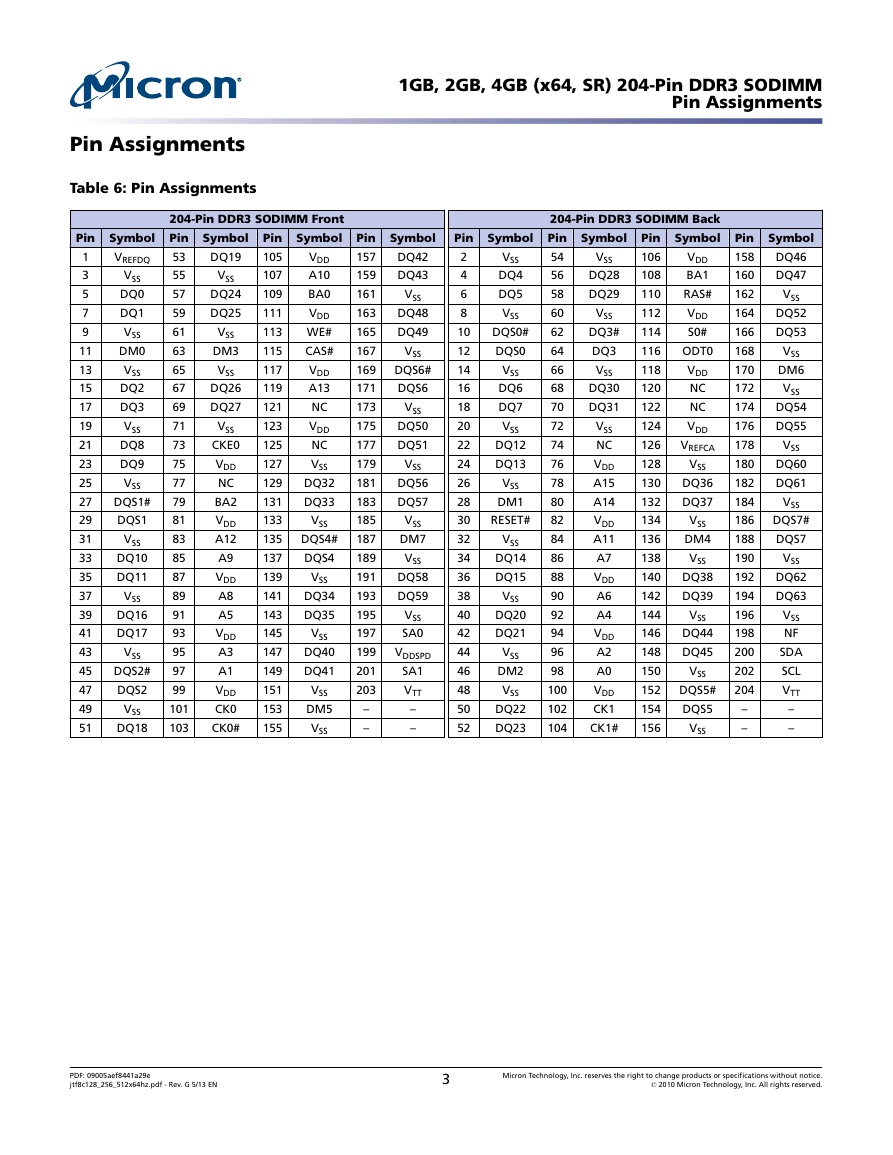
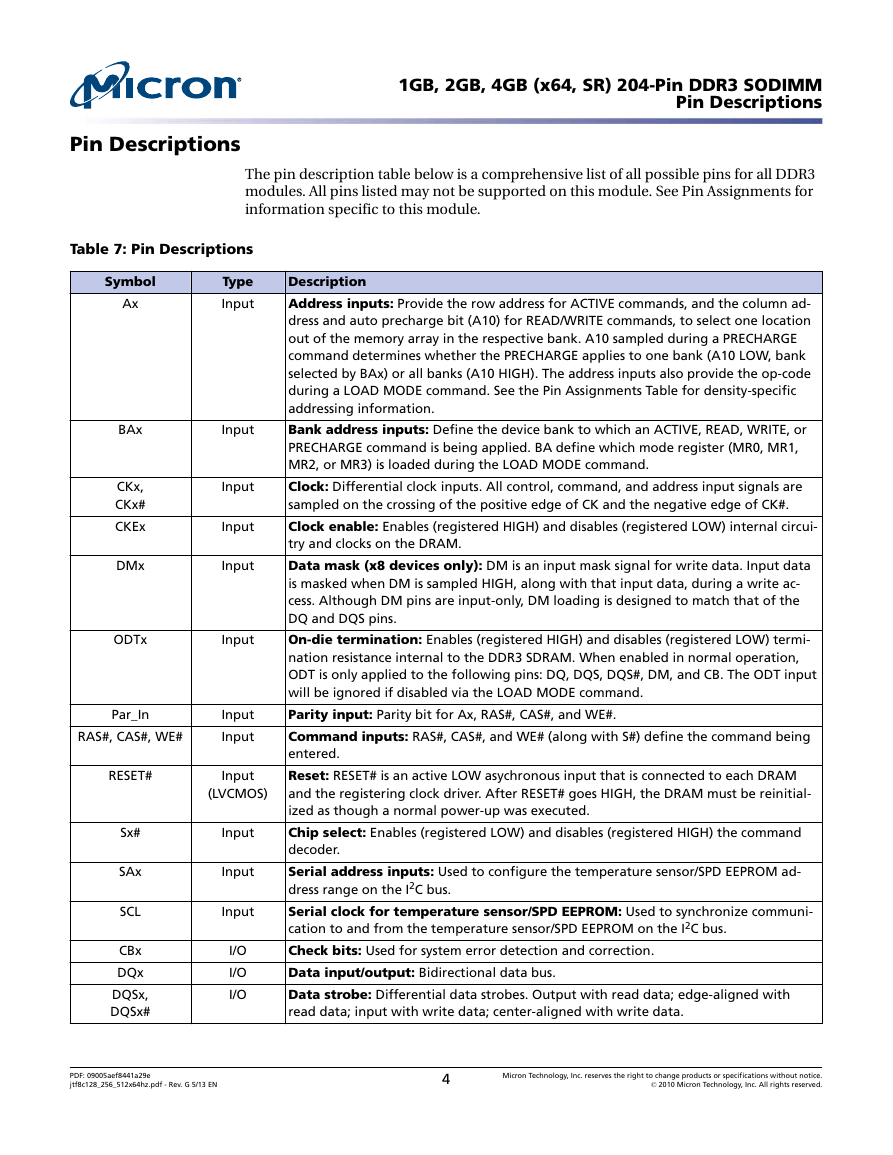
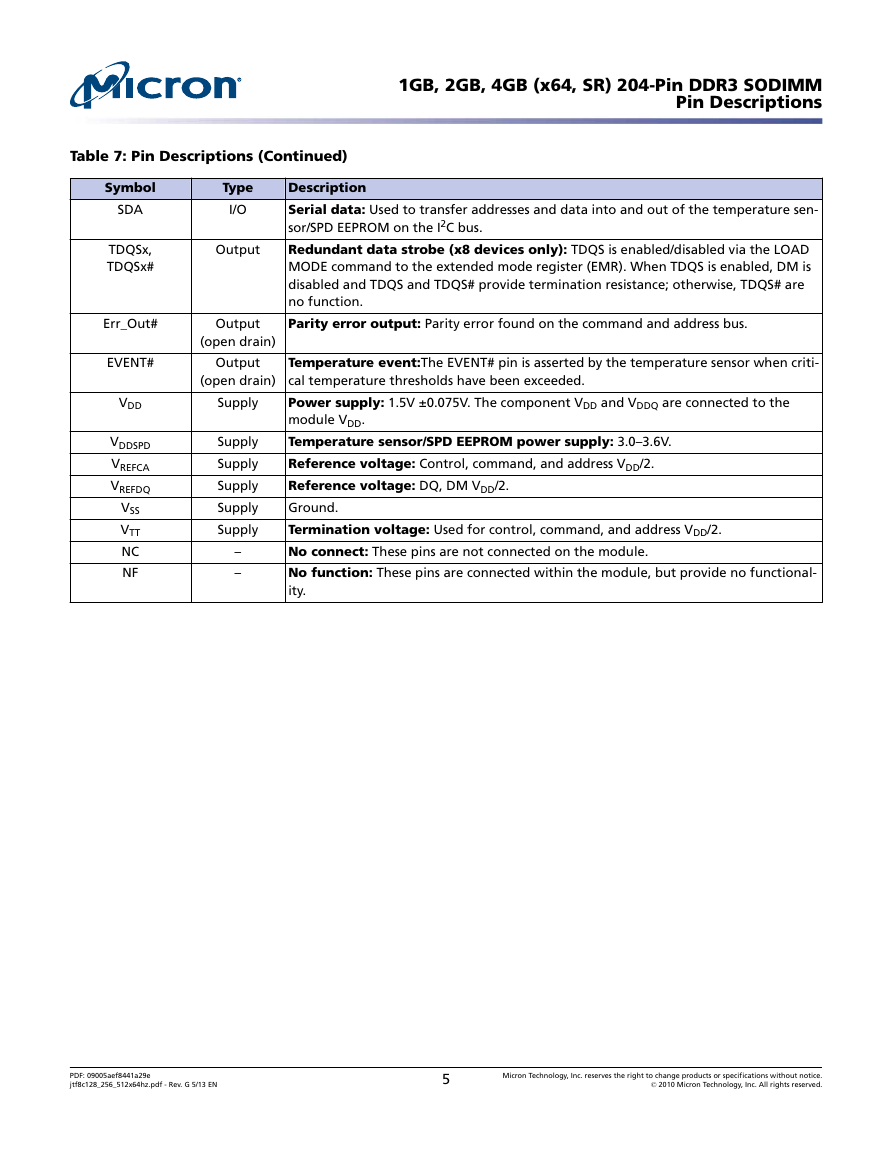
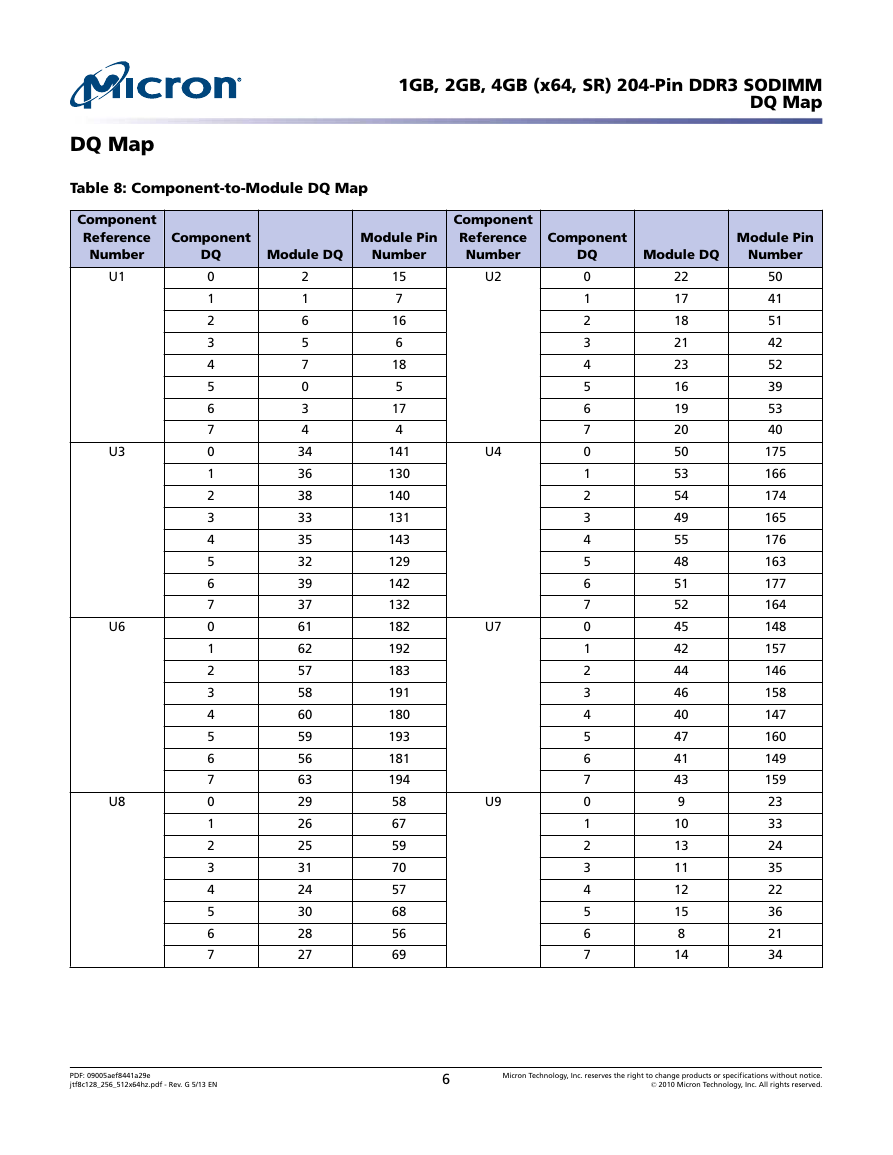
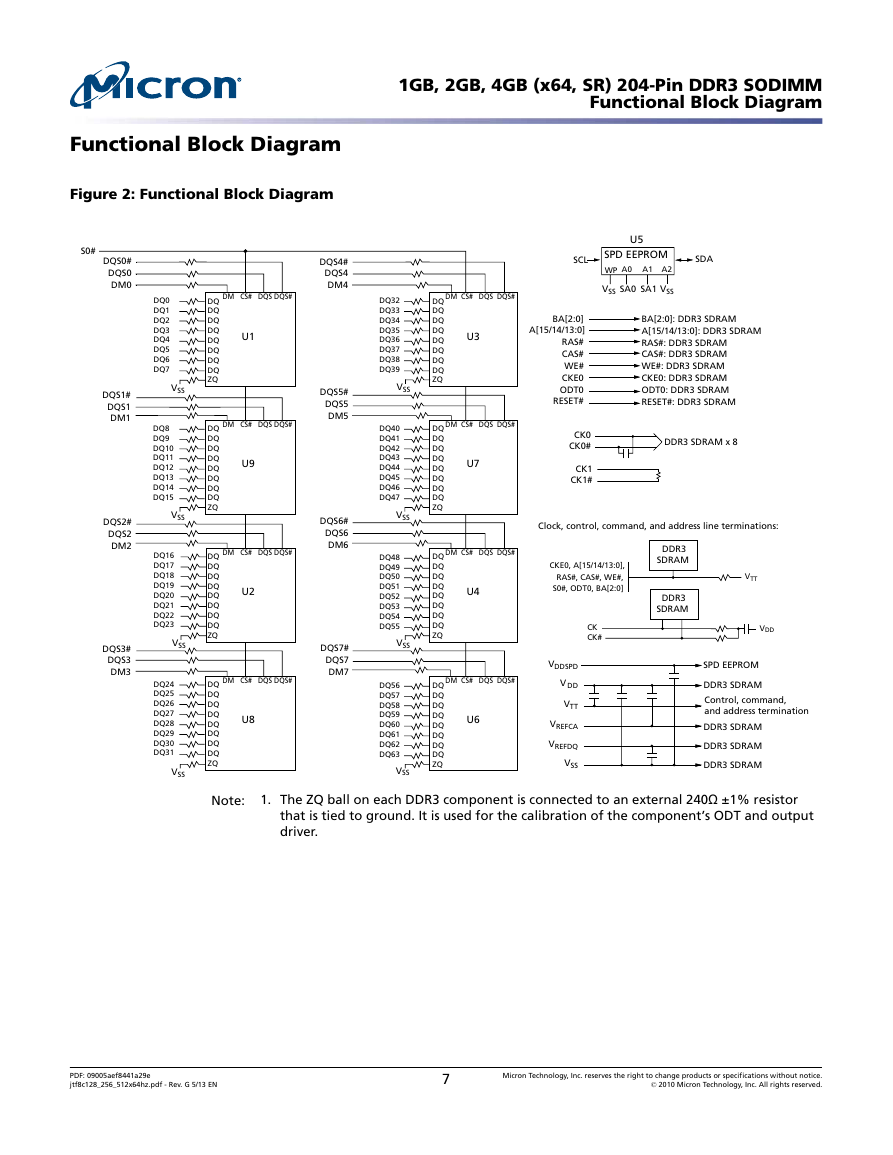
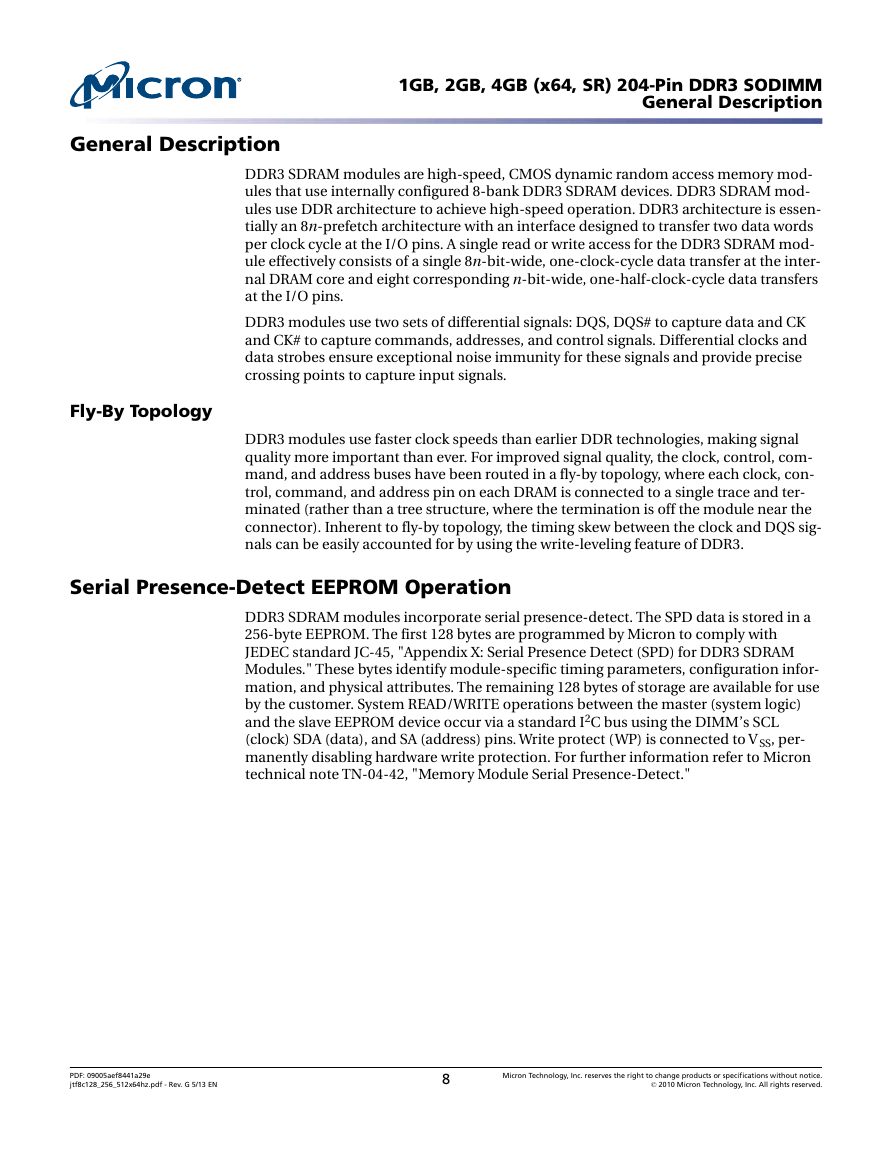








 2023年江西萍乡中考道德与法治真题及答案.doc
2023年江西萍乡中考道德与法治真题及答案.doc 2012年重庆南川中考生物真题及答案.doc
2012年重庆南川中考生物真题及答案.doc 2013年江西师范大学地理学综合及文艺理论基础考研真题.doc
2013年江西师范大学地理学综合及文艺理论基础考研真题.doc 2020年四川甘孜小升初语文真题及答案I卷.doc
2020年四川甘孜小升初语文真题及答案I卷.doc 2020年注册岩土工程师专业基础考试真题及答案.doc
2020年注册岩土工程师专业基础考试真题及答案.doc 2023-2024学年福建省厦门市九年级上学期数学月考试题及答案.doc
2023-2024学年福建省厦门市九年级上学期数学月考试题及答案.doc 2021-2022学年辽宁省沈阳市大东区九年级上学期语文期末试题及答案.doc
2021-2022学年辽宁省沈阳市大东区九年级上学期语文期末试题及答案.doc 2022-2023学年北京东城区初三第一学期物理期末试卷及答案.doc
2022-2023学年北京东城区初三第一学期物理期末试卷及答案.doc 2018上半年江西教师资格初中地理学科知识与教学能力真题及答案.doc
2018上半年江西教师资格初中地理学科知识与教学能力真题及答案.doc 2012年河北国家公务员申论考试真题及答案-省级.doc
2012年河北国家公务员申论考试真题及答案-省级.doc 2020-2021学年江苏省扬州市江都区邵樊片九年级上学期数学第一次质量检测试题及答案.doc
2020-2021学年江苏省扬州市江都区邵樊片九年级上学期数学第一次质量检测试题及答案.doc 2022下半年黑龙江教师资格证中学综合素质真题及答案.doc
2022下半年黑龙江教师资格证中学综合素质真题及答案.doc